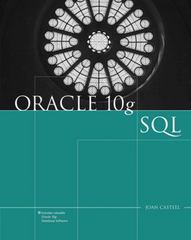Question
Hi I need help on my lexical analyzer homework using C language., So Basically we are given an input file below and we are to
Hi I need help on my lexical analyzer homework using C language.,
So Basically we are given an input file below and we are to recognize each tokens seperated by the Whitespace.
inputfile.txt
-----------------------------------------------------------------------------------------------------------------
MyShopPurchaseOrders DEFINITIONS AUTOMATIC TAGS ::= BEGIN
PurchaseOrder ::= SEQUENCE { dateOfOrder DATE, customer CustomerInfo, items ListOfItems }
CustomerInfo ::= SEQUENCE { companyName VisibleString (SIZE (3..50)), billingAddress Address, contactPhone NumericString (SIZE (7..12)) }
Address::= SEQUENCE { street VisibleString (SIZE (5 .. 50)) OPTIONAL, city VisibleString (SIZE (2..30)), state VisibleString (SIZE(2) FROM ("A".."Z")), zipCode NumericString (SIZE(5 | 9)) }
ListOfItems ::= SEQUENCE (SIZE (1..100)) OF Item
Item ::= SEQUENCE { itemCode INTEGER (1..99999), color VisibleString ("Black" | "Blue" | "Brown"), power INTEGER (110 | 220), deliveryTime INTEGER (8..12 | 14..19), quantity INTEGER (1..1000), unitPrice INTEGER (1 .. 9999), isTaxable BOOLEAN } END
-----------------------------------------------------------------------------------------------------------------
Alphabet Set :
a-z A-Z 0-9 " ( ) , - : = { } |
----------------------------------------------------------------------------------------------------------------
RESERVED WORDS:
{"AUTOMATIC", "BEGIN", "BOOLEAN", "DEFINITIONS", "END", "FROM",
"INTEGER", "NumericString", "OPTIONAL", "SEQUENCE", "SIZE", "TAGS", "VisibleString"};
-----------------------------------------------------------------------------------------------------------------------------------------------------------------
Tokens
a. Type references
Name of lexical item typereference
A "typereference" shall consist of an arbitrary number (one or more) of letters, digits, and hyphens. The initial character shall be an upper-case letter. A hyphen shall not be the last character. A hyphen shall not be immediately followed by another hyphen.
NOTE The rules concerning hyphen are designed to a void ambiguity with (possibly following) comment.
example of typereference on the input file: MyShopPurchaseOrders , PurchaseOrder, CustomerInfo, etc..
b. Identifiers
Name of lexical item identifier
An "identifier" shall consist of an arbitrary number (one or more) of letters, digits, and hyphens. The initial character shall be a lower-case letter. A hyphen shall not be the last character. A hyphen shall not be immediately followed by another hyphen.
example of identifier on the inputfile: dateOfOrder, customer, items, companyName, etc...
c. Numbers
Name of lexical item number
A "number" shall consist of one or more digits. The first digit shall not be zero unless the "number" is a single digit.
d. Assignment lexical item
Name of lexical item "::="
This lexical item shall consist of the sequence of characters: ::=
e. Range separator
Name of lexical item ".."
This lexical item shall consist of the sequence of characters: " .. "
f. { - LURLY
g. } RCURLY
h. , COMMA
i. ( LPAREN
j. ) RPAREN
k. | BAR
l. QUOTE
-----------------------------------------------------------------------------------------------------------------------------------------
Sample output of program:
typereference: MyShopPurchaseOrders
reserveword: DEFINITION
reserveword:AUTOMATIC
reserveword TAGS
assignment: ::=
reserveword: BEGIN
typereference: PurchaseOrder
and so on...
-------------------------------------------------------------------------------------------------------------------
Here is my initial code:
#include
#include
#include
int main(int argc, char *argv[]){ //running it in command line LINUX
FILE *filePtr;
switch (argc) {
case 1: // No parameters, use stdin
// printf("NO argument provided ");
filePtr = stdin;
break;
case 2: // One parameter, use .txt file supplied
if ( (filePtr = fopen(strcat(argv[1], ".txt"), "r")) == NULL ) {
printf("Cannot open input file. ");
exit(1);
}
break;
default:
printf("Syntax: scanner [file] (.txt is implicit) ");
exit(0);
}
//check if empty
fseek(filePtr, 0, SEEK_END);
if (ftell(filePtr) == 0) {
printf("File is empty. ");
exit(1);
} else {
rewind(filePtr);
}
char *ReserveWord[13] = {"AUTOMATIC", "BEGIN", "BOOLEAN", "DEFINITIONS", "END", "FROM",
"INTEGER", "NumericString", "OPTIONAL",
"SEQUENCE", "SIZE", "TAGS", "VisibleString"};
char *assignment[] = {":=="};
char *range_separator[] = {".."};
char LCURLY = {'{'};
char RCURLY = {'}'};
char COMMA = {','};
char LPAREN = {'('};
char RPAREN = {')'};
char BAR = {'|'};
char QUOTE = {'"'};
int numline = 1;
char c;
while((c = fgetc(filePtr)) != EOF){
if ( c == ' '){
numline++;
}
if (c <= 65 && c >= 90 ){ //A-Z for typeref
}
}
fclose(filePtr);
}
Step by Step Solution
There are 3 Steps involved in it
Step: 1

Get Instant Access to Expert-Tailored Solutions
See step-by-step solutions with expert insights and AI powered tools for academic success
Step: 2

Step: 3

Ace Your Homework with AI
Get the answers you need in no time with our AI-driven, step-by-step assistance
Get Started


